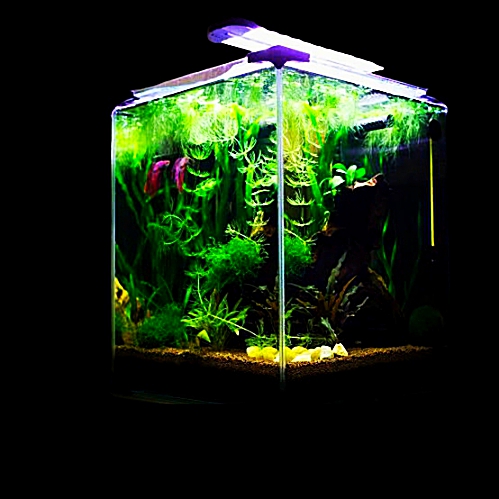I will guide you through my process for building a beautiful and detailed, yet simple 20-liter planted aquarium.
Whether you are creating your first aquascape or have built many before, my experience shows that you only need a few pieces of wood, some rocks, and a handful of plants to create a stunning layout.
Choosing a Substrate for a Simple Planted Tank
I started my aquascape with Aqua Design Amano’s Colorado sand. Compared to La Plata sand, it has a warmer, reddish tone.
Since I was not planning to plant anything directly into the substrate, I did not need to use powersand or aquasoil.
I smoothed the sand with a sand flattener, raising the back slightly to add more depth to the layout.
Building the Hardscape
I got a head start by preparing some hardscape pieces ahead of time.
I glued Coral Sinker wood to lava stones using a combination of paper towels and liquid superglue.
Before gluing, I always test to ensure my hardscape setup actually fits inside the tank.
I began with three main pieces to create the foundational structure of the aquascape, deciding on a stylish V-shaped layout.
I then added smaller branches and stones using the same paper towel and glue method.
Placing smaller pieces in the foreground helps build perspective and a greater sense of depth.
How I Secure the Hardscape Elements
To ensure a strong and stable setup, I made sure to secure each structure at a minimum of three points.
Using tweezers allowed me to place the tiny stones with more precision, which was perfect for adding extra detail to the layout.
Why I Soak Wood and Lava Rocks
Coral Sinker wood and lava rocks are both lightweight materials, so I find it is a good idea to soak them before use.
Soaking prevents them from floating once the tank is filled with water.
While it may seem obvious for wood, lava stones also benefit from a good soak.
Lava stones form when molten lava cools rapidly after a volcanic eruption, which often traps air bubbles inside.
The trapped pockets of air can cause the rocks to float.
Selecting Plants for the Aquascape
First, I trim most of the roots from the plants.
Trimming the roots results in a cleaner appearance and helps the new roots cling more effectively to the wood.
The plants I chose are epiphytes, which naturally grow on trees or rocks without needing soil.
They are very low-maintenance and make a perfect addition to planted aquariums.
The word “epiphyte” comes from Greek and literally means “on top of a plant”; they are often referred to as “air plants” as well.
I attach the plants by their roots using a gel-type superglue, which is safe for all aquatic life.
About Hygrophila pinnatifida
One of the plants I selected is Hygrophila pinnatifida, which is native to the lush landscapes of India.
With deeply lobed, reddish-brown leaves and light green undersides, it brings a striking, exotic flair to any aquarium.
As it gently sways with the water flow, it creates a beautiful, dynamic effect.
About Anubias Plants
I used several types of Anubias for my build: ‘Mini’, ‘Pangolino’, and ‘Mini Coin’.
The unique names help distinguish between the different leaf shapes and sizes.
Despite their different appearances, all Anubias varieties are native to tropical Central and West Africa, where they typically grow in rivers, streams, and swamps.
Anubias species share a slow growth rate, usually producing a new leaf only every three weeks, or even slower.
Because they thrive in shady environments, they were named after Anubis, the ancient Egyptian god of the underworld.
About Cryptocoryne lutea ‘Hobbit’
The last plant I added is a special variety of Cryptocoryne called lutea ‘Hobbit’, which is originally from Sri Lanka.
It is a compact, decorative plant with tiny leaves.
In greenhouses, it is selectively isolated from regular-sized Cryptocorynes and then propagated in a laboratory to achieve its short stature.
With a height of just a few centimeters, it is a perfect choice for nano aquariums.
Adding Finishing Details
For a finishing touch, I added a handful of Aqua Design Amano KUMU Flat River Gravel.
The gravel introduced more color and texture, rounding out the aquascape beautifully.
When to Add Livestock
A few weeks after I filled the tank, once the beneficial bacteria had established a colony, it was time to add livestock.
What Shrimp I Recommend for Nano Aquariums
When it comes to nano aquariums, shrimp are the stars of the show.
I chose the vibrant Red Rili shrimp.
The unique variety features bright red patches on the head and tail, with a translucent midsection.
The clear areas can vary in size, giving each shrimp a one-of-a-kind look.
The Result After One Month
After about a month, the aquarium has come to life beautifully.
The shrimp are thriving, the plants are lush and vibrant, and the whole setup feels like a tiny slice of nature right in my room.
The Importance of Patience in Aquascaping
Patience is essential.
Aquascaping is not just about design; it is about creating a small ecosystem, a peaceful moment you can escape into every time you glance over.
It does not matter if you are a total beginner or a seasoned professional; what matters is that you enjoy the process.
Conclusion
To build a beautiful 20-liter planted aquarium, start with a warm-toned substrate like ADA Colorado sand and create depth by sloping it slightly toward the back.
Use lightweight materials such as Coral Sinker wood and lava stones for the hardscape, securing them with superglue and soaking them beforehand to prevent floating.
Arrange the hardscape in a V-shape and enhance depth with smaller foreground elements.
Choose epiphyte plants like Hygrophila pinnatifida, various Anubias species, and Cryptocoryne lutea ‘Hobbit’ for low-maintenance beauty.
Attach plants using gel glue, trim roots for better attachment, and finish with decorative gravel.
Once the tank is cycled, add colorful Red Rili shrimp.
With patience, the result is a vibrant, natural ecosystem perfect for any aquascaping enthusiast.

My name is Chibuzor Abraham Mba, and I’m the aquarist behind this website. I’ve spent years exploring the fascinating world of aquariums—especially small-scale tanks like nano and pico setups. Over time, I’ve made my fair share of mistakes, and through each one, I’ve learned valuable lessons.
